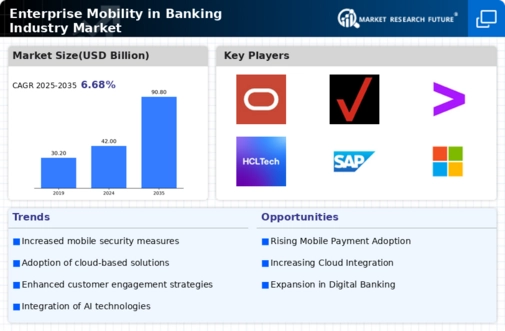Emergence of Fintech Partnerships
The emergence of fintech partnerships is reshaping the landscape of the Enterprise Mobility in Banking Industry Market. Traditional banks are increasingly collaborating with fintech companies to leverage innovative technologies and enhance their mobile offerings. This trend is evidenced by a growing number of partnerships, with over 40% of banks engaging with fintech firms to develop mobile solutions. These collaborations enable banks to access cutting-edge technologies, such as artificial intelligence and blockchain, which can significantly improve customer experience and operational efficiency. As the competition intensifies, the ability to innovate through partnerships will likely be a critical factor in the success of banks within the Enterprise Mobility in Banking Industry Market.
Regulatory Compliance and Standards
Regulatory compliance and standards are increasingly influencing the Enterprise Mobility in Banking Industry Market. Financial institutions are required to adhere to stringent regulations regarding data protection and consumer privacy, which necessitates the implementation of secure mobile solutions. Recent reports indicate that compliance-related costs for banks have risen significantly, prompting them to invest in enterprise mobility solutions that meet regulatory requirements. This focus on compliance not only mitigates risks associated with data breaches but also enhances customer confidence in mobile banking services. As regulations evolve, banks must remain vigilant and proactive in adapting their mobile strategies to ensure compliance, thereby driving growth in the Enterprise Mobility in Banking Industry Market.
Integration of Cloud Computing Solutions
The integration of cloud computing solutions is emerging as a pivotal driver in the Enterprise Mobility in Banking Industry Market. By leveraging cloud technology, banks can enhance their operational agility and scalability, allowing for more efficient management of mobile applications. Recent data suggests that nearly 60% of banks are adopting cloud-based solutions to facilitate mobile banking services. This shift enables financial institutions to deploy updates and new features rapidly, ensuring that their mobile platforms remain competitive and user-friendly. Furthermore, cloud computing supports data analytics, which can provide insights into customer behavior and preferences, thereby informing strategic decisions. As banks continue to embrace cloud technology, the Enterprise Mobility in Banking Industry Market is likely to witness accelerated growth and innovation.
Rising Demand for Remote Banking Services
The Enterprise Mobility in Banking Market is experiencing a notable surge in demand for remote banking services. Customers increasingly prefer the convenience of accessing banking services from their mobile devices, leading to a shift in how banks operate. According to recent data, approximately 70% of banking customers utilize mobile applications for transactions, indicating a strong preference for mobile banking solutions. This trend compels banks to invest in enterprise mobility solutions that enhance user experience and streamline operations. As a result, financial institutions are prioritizing the development of mobile-friendly platforms, which not only cater to customer preferences but also improve operational efficiency. The ongoing evolution in consumer behavior suggests that banks must adapt to these changes to remain competitive in the Enterprise Mobility in Banking Industry Market.
Advancements in Mobile Security Technologies
In the context of the Enterprise Mobility in Banking Industry Market, advancements in mobile security technologies play a crucial role in fostering consumer trust. As mobile banking becomes more prevalent, the need for robust security measures intensifies. Recent statistics indicate that cyber threats targeting financial institutions have increased by over 30% in the past year. Consequently, banks are compelled to adopt advanced security protocols, such as biometric authentication and end-to-end encryption, to safeguard customer data. These innovations not only protect sensitive information but also enhance the overall user experience, as customers feel more secure using mobile banking applications. The integration of cutting-edge security technologies is likely to be a key driver in the growth of the Enterprise Mobility in Banking Industry Market, as it addresses consumer concerns regarding data privacy and security.


















Leave a Comment